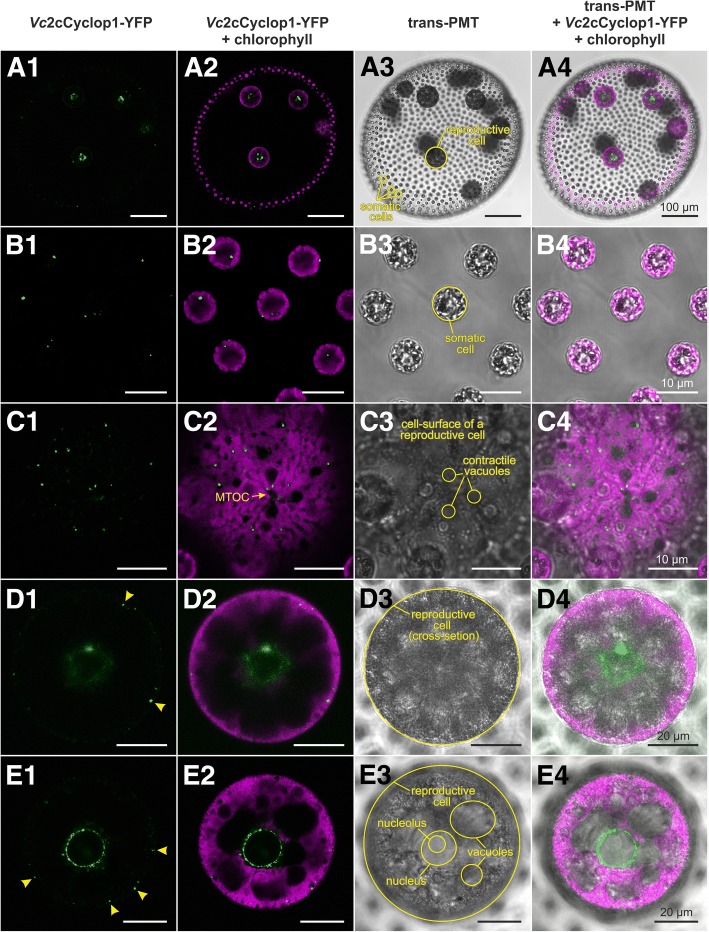Fig. 8.
In vivo localization of Vc2c-Cyclop1 in V. carteri. A1–E1 (column 1) YFP fluorescence of Vc2c-Cyclop1 fused to YFP (Vc2c-Cyclop1-YFP, green). A2–E2 (column 2) Overlay of the YFP fluorescence of Vc2c-Cyclop1-YFP (green) and the chlorophyll fluorescence (magenta). A3–E3 (column 3) Transmission-PMT image (transmitted light). A4–E4 (column 4) Overlay of transmission-PMT, YFP fluorescence of Vc2c-Cyclop1-YFP (green) and chlorophyll fluorescence (magenta). A1–A4 Overview of an entire V. carteri spheroid expressing Vc2c-Cyclop1-YFP under the control of the LHCBM1 promoter. Larger amounts of Vc2c-Cyclop1-YFP are located around the nuclei of reproductive cells. Note that tiny spots of Vc2c-Cyclop1-YFP location can be seen only with higher magnification (see below). V. carteri consists of approximately 2000 small, terminally differentiated, biflagellate somatic cells at the surface and approximately 16 large reproductive cells in the interior of a transparent sphere of glycoprotein-rich extracellular matrix. B1–B4 Close-up view of an optical cross section of somatic cells. Each somatic cell contains one to several tiny spots of Vc2c-Cyclop1-YFP location. The fluorescent spots are 0.5 to 1.0 μm in diameter (B1). C1–C4 Close-up view of the cell surface of a reproductive cell during the growth phase. There are numerous tiny spots of Vc2c-Cyclop1-YFP location close to the cell surface. The fluorescent spots are 0.5 to 1.0 μm in diameter (C1), just like the ones observed in somatic cells. The spots of Vc2c-Cyclop1-YFP location never overlap with the chlorophyll fluorescence (C2). MTOC, microtubule organizing center. D1–D4 Cross section of a reproductive cell during the growth phase. Most of Vc2c-Cyclop1-YFP is located close to the nucleus and appears as a diffuse cloud (D1, D2). Vc2c-Cyclop1-YFP also is located close to the cell surface (arrowheads in D1), which corresponds to the spots observed in C1–C4. E1–E4 Cross section of a reproductive cell shortly before onset of embryogenesis. Vc2c-Cyclop1-YFP forms as a distinct structure around the nucleus. It appears that the surface of the nucleus is studded with tiny beads of Vc2c-Cyclop1-YFP. In addition, Vc2c-Cyclop1-YFP is located close to the cell surface of the cell (arrowheads in E1). Note that this reproductive cell is more advanced in development and thus larger than the reproductive cell in D1–D4; however, the focal plane is not as deep inside the cell as in D1–D4, which makes it possible to detect several large, non-contractile vacuoles

